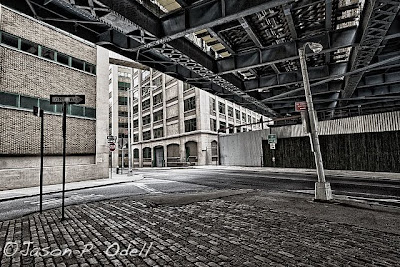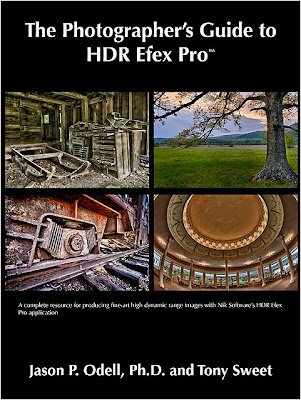Sunrise at Bear Lake, Rocky Mountain N.P., CO
High Dynamic Range Photography
Jason P. Odell, Ph.D.
Jason P. Odell, Ph.D.
A fundamental challenge for all photographers is that neither film nor digital cameras can reproduce the same range of tones as seen by the human eye. The range of dark shadows and bright tones that can be recorded-- either by film, a digital sensor, or the human eye is called dynamic range. When the dynamic range of a recording medium, like film, is smaller than what they eye can perceive, you will see areas of pure black or pure white in the image-- areas with no detail in the photograph. With traditional techniques (including digital photography), photographers have to make a conscious choice when they expose a scene with a range of tones that exceeds their camera’s dynamic range: Either allow shadows to “block up” as pure black, or allow highlights to “clip” as pure white. Alternatively, photographers could try to use filters to help “compress” the tones in a scene so that the details would be captured on their film or digital sensor.
New Jersey skyline at sunset, Battery Park, NY.

Under the Manhattan Bridge, Brooklyn, NY
Since the 1980’s, imaging scientists have experimented with ways of producing “high dynamic range” images. These images contain a range of tones far greater than what the human eye can perceive (or computer monitor can display). The concept of producing a high dynamic range, or “HDR,” image is fairly simple. Instead of taking just one exposure of a scene, the photographer creates a series of exposures of the same scene, with each exposure metered differently. The under-exposed images will preserve detail in the highlights, while the over-exposed images will capture detail in the dark shadows. This series of images is then combined digitally to create a hybrid HDR image. Until recently, HDR software was difficult to use and often produced unexpected results. More recently, several products are now available to photographers that make creating HDR images a straightforward process.
Mining train detail, Colorado Springs, CO
Lower Manhattan at dusk, New York, NY
Moon over Gateway Rock, Garden of the Gods, CO

The Photographer's Guide to HDR Efex Pro, ©2010 Jason P. Odell & Tony Sweet
In October, Nik Software released HDR Efex Pro, a program that works with many of the current industry-standard photo editing packages, to give photographers better creative control over HDR images. Unfortunately, HDR Efex Pro has no user manual. In The Photographer’s Guide to HDR Efex Pro, I collaborated with my friend and master photographer, Tony Sweet, to produce a practical user guide for producing the highest quality fine-art images with this new software application. Our guide is a combination of technical descriptions of the software tools, and also a recipe book. We present simple steps on how to create a range of HDR styles, from scenes that look absolutely natural and realistic to hyper-stylized scenes that border on the surreal. The Photographer’s Guide to HDR Efex Pro will be available by the end of 2010 from Luminescence of Nature Press (www.luminescentphoto.com).
Did you like the pictures? The full gallery of images from the book is online
here. Better yet, leave a comment on his blog and tell him.
(Mom's note: Jason does on-line and in-the-field workshops, and his photos are available for purchase. Check them out at the above website!)






15 comments:
Wonderful photography. Thanks for posting this... Now I have another blog to follow as well as yours.
Lou
Lou - Thanks for stopping by. The kid does good work! Both with his pictures and with his how-to manuals.
It's obvious he inherited your creative gene. No wonder you're so proud.
What outstanding photographs. I admire anyone who can capture more than just the basics in a picture. Kudos to Jason.
Jason's work is very impressive. I went through the slide show and was awed by some of those shots -- I love doorways and long halls so those were some of my favorites. I think in my next life, I'd like to be a photographer instead of a writer, but only if I could take photos like Jason's.
I love Jason's work! I understand why you a proud mama!
Maryann, Patricia, Wynter -- thanks. Yes, we're proud of his talents. You can tell him yourself at his blog: http://www.luminescentphoto.com/blog/
I'm sure he'll pop in later today.
These are some amazing pictures, Terry! You've got to be very proud of him. :)
These photos are so sharp and clear. Some of them almost look like paintings instead of photographs. A son to be proud of, for sure. Great accomplishments.
Thanks to everyone for all the nice comments and feedback! Tony and I are very proud of what we think is a very good book-- part technical manual and part fine-art gallery.
Enjoyed the article and the photos are awesome. He does amazing work.
Mason
Thoughts in Progress
What fabulous and atmospheric photographs. And what talent. Thanks for sharing.
I was here and told Jason how great he is.
Jason's Grandmother
I love that shot under the Manhattan Bridge - most of the HDR stuff I've seen has been broad vistas, but this architectural really shows the, uh, range of the technique.
I'll add my thanks to those who stopped by.
I'm clueless about this technique, but I know Jason's book would make it something even I could follow. All we did was put a camera in his hand when he was big enough to hold it, more to keep him occupied than with visions of this outcome.
Post a Comment